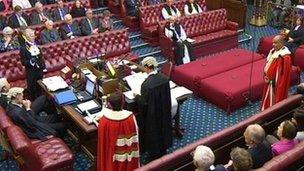Elections to replace hereditary peers 'damage Lords reputation'
- Published

There are more than 750 active members of the House of Lords and some members say it is now "full up"
Hereditary peers should not be replaced when one of their number dies as this represents a "reputational risk" for the House of Lords, a report suggests.
The last Labour government abolished the majority of hereditaries, but a rump of 90 remained pending plans for an elected chamber, which then stalled.
The the number of hereditaries should "gradually" be allowed to decline.
It also called for peers convicted of serious offences to be expelled.
The cross-party committee says the failure of the coalition government to win support last year for plans to elect up to 80% of peers should not stop a series of "small-scale" reforms being introduced now.
'Seat for life'
It says there is a consensus behind the need to remove those convicted of serious criminal offences and persistent non-attendees as well as making it easier for members to take voluntary retirement.
Unlike in the Commons, where MPs given custodial sentences of more than 12 months are automatically disqualified, peers effectively had a "seat for life", the committee said.
The majority of new peers are appointed but 18 peers have been elected to the House since 2002, when the system of by-elections to replace hereditary members who die was introduced.
All members of the House of Lords can vote in these ballots but only those on the register of hereditary peers can stand. Most recently, Lord Borwick beat off competition from 22 other candidates to win election in July.
But the committee suggested that holding elections in which only a very small number of people were entitled to take part "perpetuated the status quo" and should be phased out.
"This would also serve to reduce the reputational risk to the House which results from the existence and use of the current by-election system," it said.
"This would result in only a gradual reduction in numbers but taking this action would not preclude further, wholesale reform taking place in the future."
- Published3 September 2012
- Published7 August 2012
- Published6 August 2012